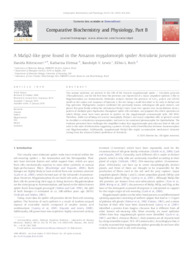A MaSp2-like gene found in the Amazon mygalomorph spider Avicularia juruensis.
A MaSp2-like gene found in the Amazon mygalomorph spider Avicularia juruensis.
Author(s): BITTENCOURT, D. M. de C.; DITTMAR, K.; LEWIS, R. V.; RECH FILHO, E. L.
Summary: A MaSp2-like gene found in the Amazon mygalomorph spiderAvicularia juruensisDaniela Bittencourta,?, Katharina Dittmarb, Randolph V. Lewisc, Elíbio L. RechdaLaboratory of Molecular Biology, EMBRAPA Western Amazon, BrazilbDepartment of Biological Sciences, SUNY at Buffalo, USAcDepartment of Molecular Biology, University of Wyoming, USAdLaboratory of Gene Transfer, Biotechnology Unit, EMBRAPA Genetic Resources and Biotechnology, Brazilabstractarticle infoArticle history:Received 22 October 2009Received in revised form 16 January 2010Accepted 17 January 2010Available online 21 January 2010Keywords:AmazonSpidersMygalomorphSilkMaSp2EvolutionTwo unique spidroins are present in the silk of the Amazon mygalomorph spider—Avicularia juruensis(Theraphosidae), and for thefirst time the presence and expression of a major ampullate spidroin 2-like inMygalomorphae are demonstrated. Molecular analysis showed the presence of (GA)n,poly-A and GPGXXmotifs in the amino acid sequence of Spidroin 2, the last being a motif described so far only in MaSp2 andFlag spidroins. Phylogenetic analysis confirmed the previously known orthologous silk gene clusters, andplaced this genefirmly within the orbicularian MaSp2 clade. Gene tree–species tree reconciliations show apattern of multiple gene duplication throughout spider silk evolution, and pinpoint the oldest speciation inwhich MaSps must have been present in spiders on the mygalomorph–araneomorph split, 240 MYA.Therefore, while not refuting orb weaver monophyly, MaSp2s, and major ampullate silks in general cannotbe classified as orbicularian synapomorphies, but have to be considered plesiomorphic for Opisthothelae. Theevidence presented here challenges the simplified notion that mygalomorphs spin only one kind of silk, andadds to the suite of information suggesting a pattern of early niche diversification between Araneomorphaeand Mygalomorphae. Additionally, mygalomorph MaSp2-like might accommodate mechanical demandsarising from the arboreal habitat preference ofAvicularia.
Publication year: 2010
Types of publication: Journal article
Unit: Embrapa Western Amazon
Keywords: Evolução
Observation
Some of Embrapa's publications are published as ePub files. To read them, use or download one of the following free software options to your computer or mobile device. Android: Google Play Books; IOS: iBooks; Windows and Linux: Calibre.
Access other publications
Access the Agricultural Research Database (BDPA) to consult Embrapa's full library collection and records.
Visit Embrapa Bookstore to purchase books and other publications sold by Embrapa.

